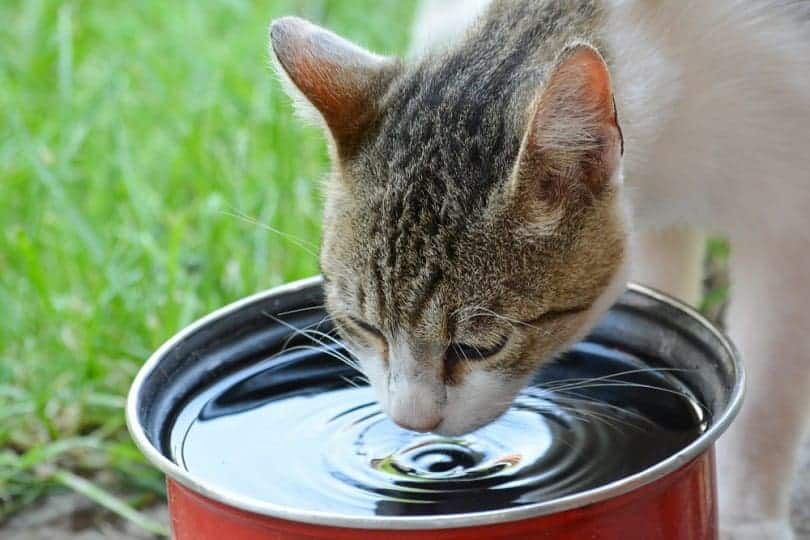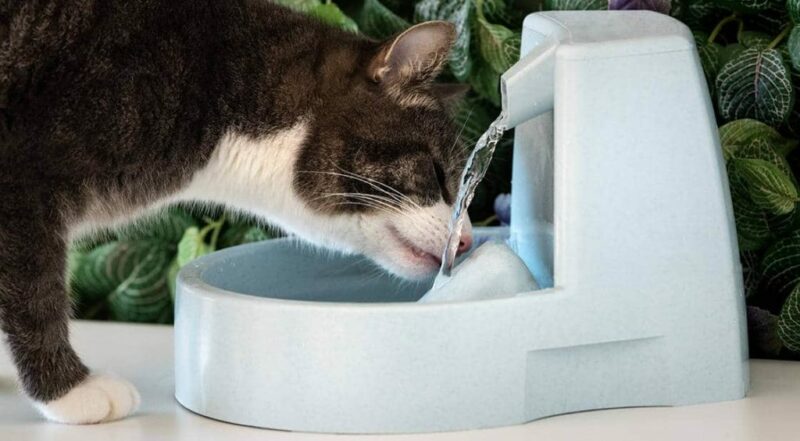If you have the convenience of a cat water fountain, you know that it’s changed the ballgame for how your cat gets their hydration. The water is super fresh, but it requires occasional maintenance, as you already know.
Cleaning depends a lot on your cat’s water fountain’s brand and style. However, most of the time, it’s relatively the same. But we urge you to read the care directions from your purchase.

How to Clean a Cat Water Fountain
- White vinegar
- Spray bottle
- Sponge
- Cloth
- Warm, clean water
Unfortunately, cleaning a cat water fountain will be more complicated than rinsing and washing a standard bowl, but giving your cat a free-flowing freshwater source is probably worth it for you.
Why Vinegar? Here’s the Answer

You probably read all over the web that white vinegar is a cure-all for everything. It seems like it’s used in all organic cleaners and other hygienic products to enhance daily living. It’s also a fantastic resource to use when cleaning your cat’s water fountain. If you’ve ever used it in your coffee pot, it’s kind of the same concept. It just gives an extra powerful clean that is entirely organic and safe for your cat.
Using harsh commercial cleaners can be far too abrasive for the fountain’s material, but it also might pose toxic risks for your cat. Vinegar is an all-natural alternative with no ill effects for your cats, permitting it to be adequately diluted and not full potency.
Vinegar Mixture
You can make a simple vinegar-cleaning mixture with one part vinegar to three parts water.
How to Clean a Cat Water Fountain in 7 Simple Steps
Here, we can walk you through the steps to clean your cat’s water fountain. However, if you’re more of a visual learner, it might benefit you to hop on YouTube or Google to find an actual video of disassembly and cleaning.
If you’re having any trouble during the process, pause what you’re doing and get some help. The good news is, once you’ve done it one time, it’ll be a breeze every time after that. Let’s get to it.
1. Give Your Cats a Temporary Water Source

If you’re taking away their primary water bowl for routine cleaning, it is essential to have another bowl with fresh available water. You might already have an extra on hand, but if not, it’s time to get one out of the cupboard.
2. Gather Necessary Instructions & Materials
Follow the supply list at the top of this article, gathering up these few items. Once you have each one, you can organize yourself before you begin.
3. Unplug and Empty
Ensure that you unplug the water fountain entirely from the wall and empty any water currently in the fountain, which includes any hidden compartments or internal sources.
Follow specific instructions on your water fountain care sheet to see how.
4. Remove the Main Tank
You’re going to want to remove the main tank, as it will likely be in the way of your motor. You need to dismantle it to reach all those hard-to-get places. You can remove it as it shows on the individual model, but you can always watch a YouTube tutorial video to walk you through the steps visually.
5. Disassemble Motor
If you clean the entire fountain, you can’t get the motor wet. So, disassembling the fountain to remove the motor is an important step. While all water fountains can be different, you will need to remove the front-facing panel, exposing the internal motor unit. Remove as instructed.

6. Clean Motor Chamber
Now that you’ve removed the motor, it’s safe to clean the internal area. Spray liberally with your vinegar mixture and wipe down. Even though it might not seem like this is a crucial step, debris can get stuck throughout the system and create a bacteria buildup. So, it’s good to get all the nooks, crannies, and crevices.
Once you finish wiping it down with vinegar, you can use warm, clean water to rinse the pieces.
7. Toss It in the Dishwasher

All of the components that can get wet can go in the dishwasher. If you choose to put these components in your dishwasher, you should wash them only with other cat-related products to prevent cross-contamination to your family.
Once you run the cycle, make sure all sections are completely dry for reassembling.
Frequent Asked Questions
How often should you clean a cat water fountain?
If you want to reduce slime buildup in the fountain, it’s best to clean it thoroughly one to three times a week, depending on how many cats are in the home.
Why is it important to clean pet water fountains?
Cat water fountains stay fresher longer than traditional water bowls since it’s constantly flowing. However, bacteria is still a real thing that can build up in the water fountain, so routine care is crucial.
Sludge buildup is expected, which is why it is so problematic when you don’t dismantle the entire fountain while cleaning.
What are the downfalls of water fountains for cats?
Water fountains have their upsides, but if you would like to consider all of the downsides of owning a water fountain, think about the cleaning frequency.
While it might seem fine to let water free flow, you have to think about the maintenance. As mentioned above, you’ll have to clean the cage every few days to keep up with hygiene and prevent slime buildup.
Why use cat water fountains?
You might already have a cat water fountain but not be thoroughly familiar with the benefits. It might seem like a good idea just because it’s a new product that seems innovative, but it’s more than just that. The feline group in the wild gets most of their hydration from the prey they consume.
Since most traditional house cats have a dry kibble diet, they don’t get nearly as much moisture from their food source. So, they often forget to drink what they should. The trickling from the water fountain can entice your cat to drink more, which is ideal.
Not every cat water fountain will make your life easier. This is why we recommend the well-designed Hepper Stainless Steel Cat Water Fountain, which has advanced triple filtration, three different flow modes, and an automatic shutoff feature.
- Premium 304-Grade Stainless Steel - This metal cat water fountain is hygienic, with superior...
- Serene & Healthy Cat Drinking Fountain Experience - With whisper-quiet pumping & an advanced...
- Say Goodbye to Dehydration - Provide your cat with a constant source of flowing water with this...
This modern, minimalist fountain runs surprisingly quietly and is very easy to clean.
At Catster, we’ve admired Hepper for many years and decided to take a controlling ownership interest so that we could benefit from the outstanding designs of this cool cat company!
Are cat water fountains safe?
Cat water fountains can be very safe when used as instructed in the manual. However, because it is an electrical machine, cats that get into trouble chewing chords might have a bit of an issue. Always try to keep cords out of sight to prevent unwanted chewing.
Final Thoughts
If you have recently invested in a cat water fountain, you already know the benefits of using one of these grand inventions. But it’s still something that you should maintain as directed.
We urge you to look at the specific care instructions on the particular water fountain you have, as every fountain is slightly different in composition.
Once you learn how to clean your cat’s water fountain, you won’t need a tutorial the next time. It’ll be a breeze for you to remember, and you can keep your cat’s water source fresh.
Featured Image Credit: Daria Kulkova, Shutterstock
Contents
- How to Clean a Cat Water Fountain
- Why Vinegar? Here’s the Answer
- How to Clean a Cat Water Fountain in 7 Simple Steps
- 1. Give Your Cats a Temporary Water Source
- 2. Gather Necessary Instructions & Materials
- 3. Unplug and Empty
- 4. Remove the Main Tank
- 5. Disassemble Motor
- 6. Clean Motor Chamber
- 7. Toss It in the Dishwasher
- Frequent Asked Questions
- How often should you clean a cat water fountain?
- Why is it important to clean pet water fountains?
- What are the downfalls of water fountains for cats?
- Why use cat water fountains?
- Are cat water fountains safe?
- Final Thoughts













